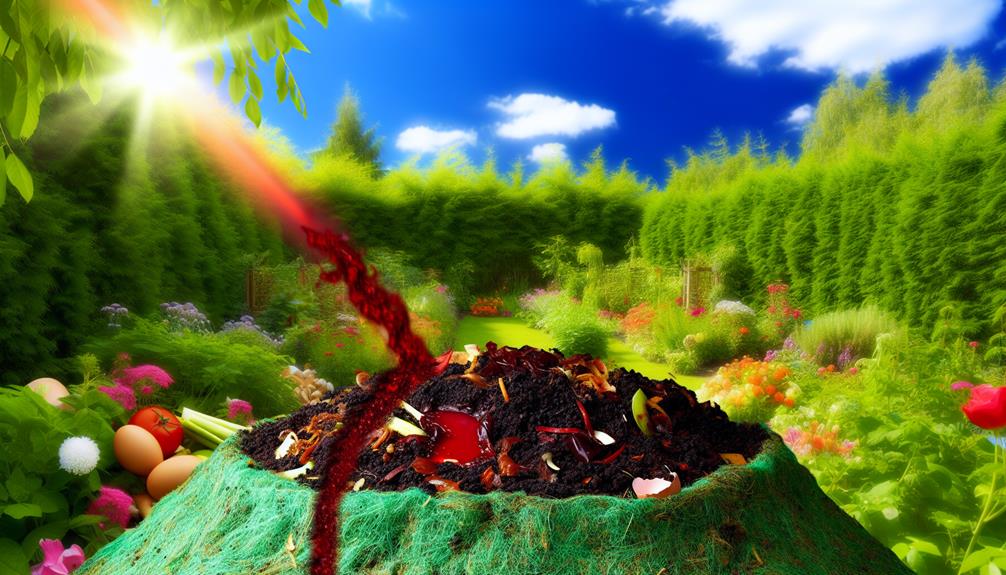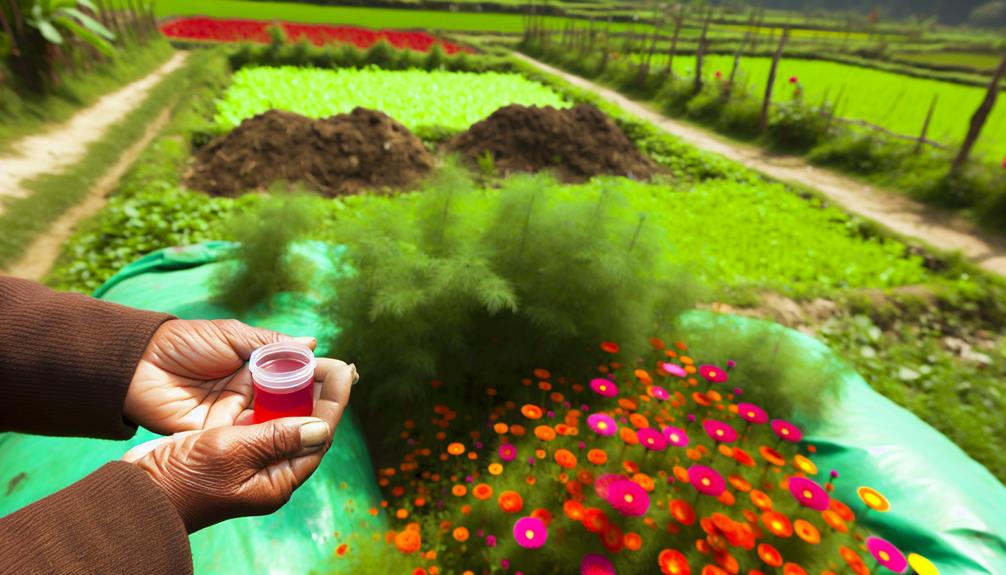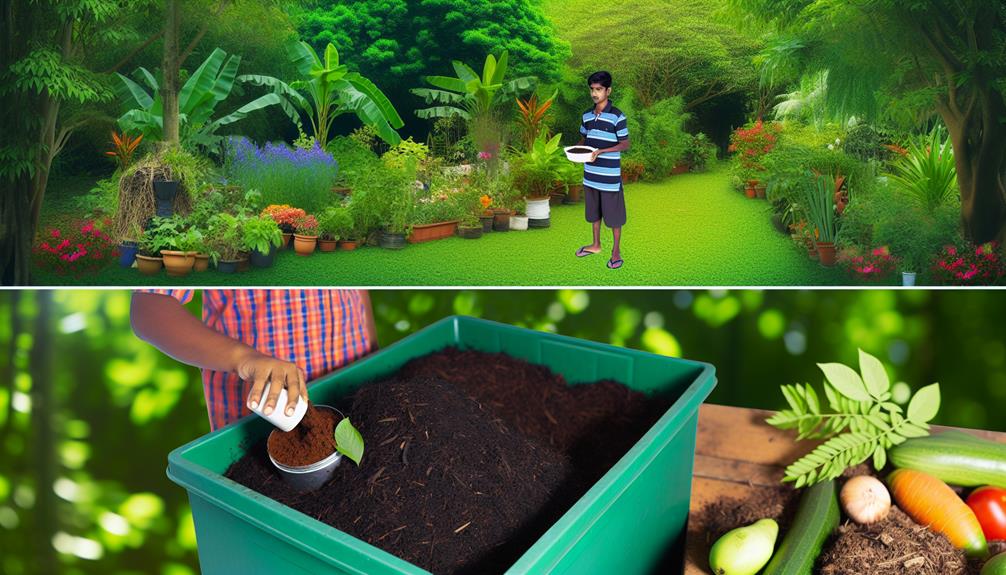

Yes, you can compost blood! Blood meal, or dried animal blood, is an excellent source of nitrogen, essential for plant growth. Adding it to your compost pile enriches soil, boosts microbial activity, and transforms waste into a valuable resource for your garden. To guarantee safety and effectiveness, mix blood meal evenly with other compost materials, including carbon-rich elements.
Maintain proper moisture levels and monitor your compost’s temperature to secure its success. With correct handling, blood meal can make your compost incredibly fertile, supporting lush, vibrant plant growth. Curious about more ways to use blood in your garden?
Composting blood offers several compelling benefits for your garden and the environment. By incorporating blood into your compost, you enrich the soil with essential nutrients, promote healthier plant growth, and contribute to waste reduction.
Here’s why you should consider it:
Embracing this practice connects you to a community dedicated to sustainable and eco-friendly gardening, fostering a sense of belonging and purpose.
While composting blood offers numerous benefits, it’s important to be mindful of potential risks and concerns to guarantee the process is safe and effective. Blood can attract pests, emit unpleasant odors, and spread pathogens if not handled correctly. Ensuring you mix blood well into the compost and avoid large quantities can mitigate these risks.
Here’s a quick overview of potential issues and solutions:
| Potential Issue | Solution |
|---|---|
| Attracting pests | Cover compost with soil |
| Unpleasant odors | Mix thoroughly and add browns |
| Pathogen spread | Maintain high composting temps |
| Excess nitrogen | Balance with carbon-rich material |
You’ll be amazed at how blood enriches your compost with its incredible nutrient profile. Packed with nitrogen, it greatly boosts the decomposition process, making your compost richer and more fertile. Additionally, blood contains essential trace minerals that enhance soil health, leading to more robust plant growth.
Blood is rich in nitrogen, making it an excellent addition to compost for boosting nutrient content. When you add blood to your compost, you’re enriching it with one of the most crucial nutrients for plant growth. Nitrogen is essential for photosynthesis and helps create lush, green foliage. In your compost, blood acts as a powerful activator, speeding up the decomposition process.
Here are three key benefits of using blood in your compost:
In addition to its high nitrogen content, blood provides a wealth of trace minerals that can greatly enrich your compost. These trace minerals, though needed in smaller amounts, play an essential role in plant health. By adding blood to your compost, you’re introducing vital elements that plants need to thrive.
| Trace Mineral | Benefit to Plants |
|---|---|
| Iron | Enhances chlorophyll production |
| Zinc | Supports enzyme function |
| Copper | Aids in metabolism |
| Manganese | Vital for photosynthesis |
| Magnesium | Central to chlorophyll molecule |
These minerals ensure your compost supports strong plant growth, giving you a more vibrant garden. Embrace this natural fertilizer to create a thriving, nutrient-rich environment for your plants. Your garden will thank you!
Also Read: Can You Compost Ash?
When sourcing blood for composting, you’ve got to take into account ethical sources, like slaughterhouses that follow humane practices.

Handling precautions are essential to prevent contamination, so always use proper protective gear and storage methods.
Sustainable collection methods guarantee that you’re not harming the environment or depleting resources, making your composting efforts both effective and responsible.
As you start the journey of composting blood, guaranteeing it comes from ethical and safe sources is paramount. You want to contribute to a sustainable and responsible cycle.
so consider these key points:
Handle blood with the utmost care to prevent contamination and health risks. When sourcing blood for composting, always make sure it comes from a reputable source. Wear protective gloves and use clean, sterilized containers to collect and transport the blood. This helps keep pathogens at bay and guarantees your compost remains safe.
Here’s a quick guide to safe blood handling:
| Precaution | Why It’s Important | How to Implement |
|---|---|---|
| Wear Gloves | Prevents direct contact | Use disposable gloves |
| Sterilize Tools | Avoids contamination | Clean with disinfectant |
| Use Fresh Blood | Reduces pathogen risk | Source and use promptly |
To sustainably source blood for composting, establish partnerships with local butchers, abattoirs, and meat processors. These relationships will guarantee you get a steady and safe supply of blood.
Here are three key steps to follow:
Also Read: Can You Compost Almond Shell?
Before adding blood to your compost pile, start by ensuring it’s free of contaminants and mixed with carbon-rich materials. This step is essential because contaminants can disrupt the composting process, and carbon-rich materials help balance the nitrogen in blood.
Begin by straining the blood to remove any foreign particles. Next, blend it with sawdust, straw, or shredded leaves. These materials not only help absorb moisture but also improve aeration, preventing your compost from becoming too wet or smelly.
Mixing thoroughly is key, so take your time to achieve an even consistency. By carefully preparing the blood, you’re setting up your compost for success, ensuring it breaks down efficiently and enriches your soil with valuable nutrients.
Regularly adding blood to your compost pile can greatly enhance its nitrogen content and accelerate the decomposition process. You’re creating a richer, more fertile compost that benefits your garden immensely.
Here’s how you can incorporate blood effectively:
Keep a close watch on your compost pile to make sure it’s progressing as expected and remains healthy. Regularly check the temperature, aiming for it to stay between 135-160°F, which helps kill pathogens and speed up decomposition.
Turn the pile every few days to guarantee even aeration and moisture distribution. If it smells bad, it might be too wet or not getting enough oxygen, so adjust accordingly. Look out for signs of pests and take action if needed.
Make sure the pile remains moist like a wrung-out sponge, but not soggy. By monitoring these factors, you’ll ensure your compost breaks down efficiently, creating rich, nutrient-dense soil that you and your gardening community can be proud of.
Also Read: Can You Compost Agave?
While maintaining your compost, you might wonder about other sustainable uses for blood in your gardening practices. Blood can be an excellent addition to your garden if used correctly.

Here are three alternative uses:
Composting blood is an innovative, eco-friendly way to enrich your soil with essential nutrients. You’ll not only reduce waste but also boost your garden’s health.
Just make sure you source blood safely, prepare it properly, and monitor your compost pile. This method can transform your gardening routine, making it more sustainable and productive.
Engage in blood composting with enthusiasm, and watch your plants thrive like never before.
Happy composting!

Don't let aphids, slugs, and caterpillars ruin another plant. Take back control with simple, natural methods that actually work.